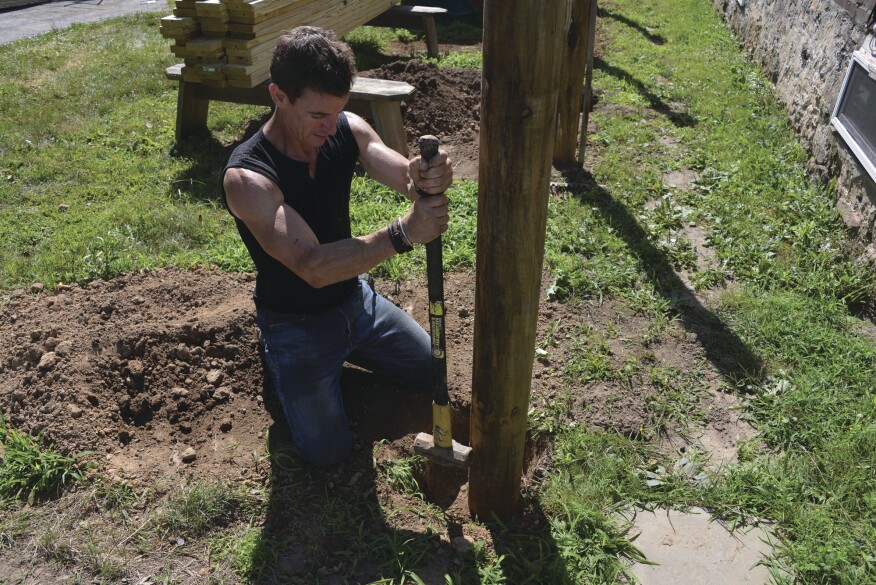Building A Beautiful And Functional Living Fence

Table of Contents
Choosing the Right Plants for Your Living Fence
Selecting the right plants is crucial for a successful living fence. The ideal living fence plants will thrive in your specific climate and soil conditions, providing the desired height, density, and aesthetic appeal. Consider these factors when making your choice:
- Climate and Soil: Research plants that are hardy in your local climate zone and adapt well to your soil type. A soil test can help determine your soil's pH and nutrient levels, allowing you to choose plants that will flourish.
- Height and Density: Determine the desired height and density of your living fence. For complete privacy, choose fast-growing privacy hedge plants that create a dense screen. Consider the mature size of the plants to avoid overcrowding.
- Evergreen vs. Deciduous: Evergreen options, like Leyland Cypress and Arborvitae, provide year-round privacy and screening. Deciduous options, offering seasonal color changes, can add visual interest.
- Disease and Pest Resistance: Selecting disease-resistant plants minimizes maintenance and reduces the need for chemical treatments.
- Plant Examples: Popular choices for living fence plants include:
- Leyland Cypress: A fast-growing evergreen known for its dense foliage and tall height.
- Arborvitae: A versatile evergreen with various sizes and colors, offering excellent screening.
- Privet: A popular choice for its dense growth and tolerance of various conditions.
- Holly: Offers year-round interest with its dark green leaves and bright red berries (certain varieties).
- Bamboo: A fast-growing option but requires careful consideration due to its invasive potential in some climates. Choose clumping varieties to prevent uncontrolled spread.
Choosing the right plants is the cornerstone of a successful living fence project. Understanding their growth habits and mature size will determine the final look and functionality of your fence.
Planning and Preparation for Your Living Fence Project
Proper planning is essential for a thriving living fence. Before you plant a single seedling, consider these key steps:
- Determine Dimensions: Decide on the desired length and height of your living fence. Account for the mature size of your chosen plants.
- Mark the Location: Use stakes and string to clearly mark the planned location of your living fence. This ensures accurate planting and a straight line.
- Soil Preparation: Prepare the soil by tilling to a depth of at least 12 inches. Amend the soil with compost or other organic matter to improve drainage and fertility. This site preparation is crucial for healthy plant growth. A soil test will inform you of necessary amendments.
- Edging: Consider adding a border or edging to create a clean line between your living fence and the surrounding landscape. This prevents weeds from encroaching.
- Local Regulations: Check local regulations and bylaws regarding fence height and planting restrictions before you begin.
- Soil Testing: Conduct a soil test to determine its pH, nutrient levels, and composition. This allows you to tailor your soil preparation to the specific needs of your chosen plants. Amendments like lime or fertilizer can correct imbalances and promote healthy growth.
Careful fence planning and thorough site preparation will significantly increase the chances of success for your living fence installation.
Planting and Maintaining Your Living Fence
Once you've chosen your plants and prepared the site, it's time for planting and ongoing maintenance.
- Planting: Plant your seedlings at the correct spacing, following the recommendations for your chosen species. Water thoroughly after planting.
- Watering: Water regularly, especially during dry periods, to establish a strong root system. Consistent watering, particularly in the first year, is crucial for healthy growth.
- Mulching: Apply a layer of mulch around the plants to conserve moisture, suppress weeds, and regulate soil temperature.
- Fertilizing: Fertilize as needed to promote healthy growth. Follow product instructions carefully, and avoid over-fertilizing.
- Pruning: Regular hedge trimming is crucial to maintain the shape and density of your living fence. Learn proper pruning techniques to avoid damaging the plants.
- Pest and Disease Control: Address pest and disease problems promptly. Consider using organic methods whenever possible.
- Proper Pruning Techniques: Use sharp, clean pruning shears to make clean cuts. Regular pruning encourages dense growth and maintains the desired shape. Images demonstrating proper pruning techniques can be found online and in gardening guides.
Consistent living fence maintenance, including watering, fertilizing, and pruning, is key to a beautiful and healthy living fence.
The Benefits of a Living Fence Beyond Aesthetics
A living fence offers a multitude of benefits beyond its aesthetic appeal:
- Privacy and Noise Reduction: A dense living fence provides excellent privacy and significantly reduces noise pollution. It acts as a natural sound barrier.
- Enhanced Property Value: A well-maintained living fence adds to the curb appeal and value of your property.
- Environmental Benefits: Living fences contribute to carbon sequestration, create wildlife habitats, reduce soil erosion, and improve water drainage. They also naturally purify the air.
- Cost-Effective: While the initial investment may be similar to traditional fencing, a living fence provides a long-term, cost-effective solution, reducing the need for frequent repairs and replacements. Its environmental benefits add further value.
These additional living fence benefits underscore its role as a sustainable and environmentally responsible landscaping choice. It provides a substantial return on investment both financially and ecologically.
Conclusion
Building a beautiful and functional living fence is a rewarding project that offers numerous aesthetic and practical benefits. By carefully selecting plants, preparing the soil properly, and following a consistent maintenance schedule, you can create a stunning natural barrier that enhances your property for years to come. A living fence offers a sustainable and visually appealing alternative to traditional fencing materials.
Start planning your dream living fence today! Research the best plants for your climate and begin your journey toward a greener, more beautiful landscape. Learn more about choosing the right plants for your living fence and transform your outdoor space!

Featured Posts
-
 Secure Your Pair Buying Nike Air Jordan 9 Retro Cool Grey Online
May 29, 2025
Secure Your Pair Buying Nike Air Jordan 9 Retro Cool Grey Online
May 29, 2025 -
 Pokemon Tcg Pocket Shining Revelry A Difficult Completion
May 29, 2025
Pokemon Tcg Pocket Shining Revelry A Difficult Completion
May 29, 2025 -
 Prakiraan Cuaca Jawa Tengah 24 April 2024 Antisipasi Hujan Sore Hari
May 29, 2025
Prakiraan Cuaca Jawa Tengah 24 April 2024 Antisipasi Hujan Sore Hari
May 29, 2025 -
 Fariolis Opvolger Van Der Gijps Kritische Blik
May 29, 2025
Fariolis Opvolger Van Der Gijps Kritische Blik
May 29, 2025 -
 Alonso Eyes Arsenals Forgotten Talent A Repeat Of The Xhaka Success
May 29, 2025
Alonso Eyes Arsenals Forgotten Talent A Repeat Of The Xhaka Success
May 29, 2025
